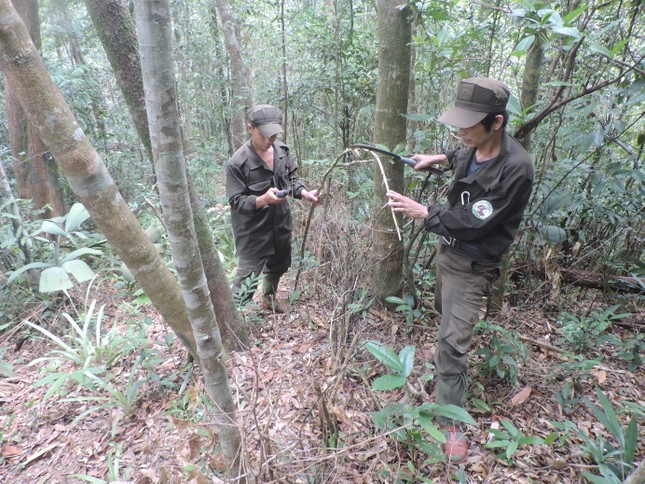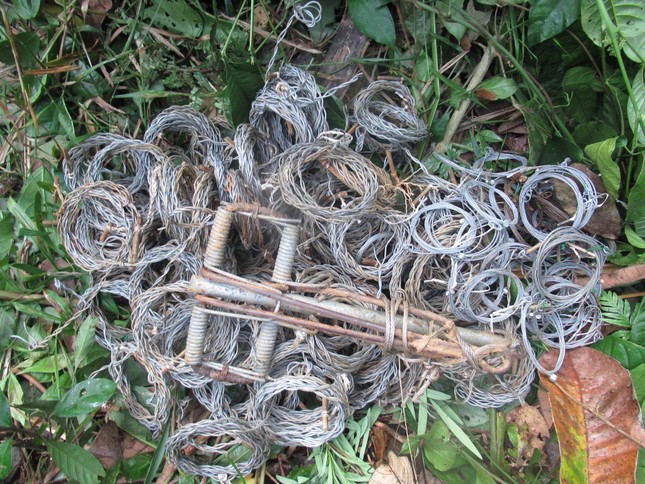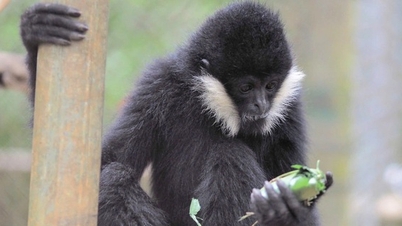TPO - For 11 years, rangers at the Saola Conservation Area in Thua Thien Hue and Quang Nam provinces have persistently patrolled and removed wire snares, helping to reduce the number of snares by 40%, contributing to reducing threats to wildlife in one of the most biodiverse areas in Vietnam.
Sao La Nature Reserve in Thua Thien Hue and Quang Nam provinces is known as one of the most biodiverse places in Vietnam. It is home to a number of rare and endangered endemic species such as the large-antlered muntjac, Truong Son muntjac, ow civet, Truong Son striped rabbit , crested pheasant, grey-shanked and brown-shanked douc langurs, and several species of pheasant.
In recent years, the wildlife population here has been seriously threatened. One of the main reasons is the use of wire traps to hunt indiscriminately. The effort and cost of setting traps are low, the efficiency is high, and they can operate for many months, which is why this type of trap is spread everywhere in Sao La Nature Reserve in particular and many other nature reserves across the country.
According to the World Wildlife Fund (WWF-Vietnam), snares are particularly serious in Southeast Asia, causing wildlife populations to decline in many areas.
A recent scientific survey found that snares pose a more direct and serious threat to fauna in Southeast Asia than forest degradation in some areas. In the Annamite Mountains that straddle the Vietnam-Laos border, snares have pushed many endemic species to the brink of extinction, including the saola, large-antlered muntjac, Annamite striped rabbit, and silver-backed chevrotain.
 |
Forest patrols at Sao La Nature Reserve remove wire snares. Photo: WWF - Vietnam. |
In order to reduce the number of snares in Sao La Nature Reserve, from 2011 to 2021, WWF-Vietnam and local authorities have implemented a snare removal campaign with regular patrols by rangers. This solution is encouraged for its simplicity, non-controversial nature, and high efficiency.
In 11 years, nearly 120,000 snares have been removed in the Sao La Reserve - a very encouraging result because removing snares is a labor-intensive job, requiring rangers to trek through the forest for long days, over high and rugged mountainous terrain.
An international team of scientists from the Leibniz Institute for Zoo and Wildlife Research, WWF, and the Universities of Exeter and Montpellier analysed 11 years of patrol data and concluded that increased snare removal could significantly reduce the threat posed by snares to wildlife. The effect was more pronounced in areas that were more accessible and patrolled more frequently. The experts say snare removal should be considered an important wildlife conservation measure.
 |
Wire snares are removed at Sao La Conservation Area in Thua Thien Hue and Quang Nam. Photo: WWF - Vietnam. |
However, while conservationists stress the importance of removing snares, they also say that this alone is not enough. Research shows that reducing snare numbers becomes more difficult even if patrols are maintained. Snaring rates remain relatively high in remote forest areas. Experts also found that snaring rates decline mainly during the first six years of patrols. After that, snare frequency does not decrease despite continued patrol efforts.
Andrew Tilker, Leibniz-IZW expert and Re:wild Species Conservation Programme Coordinator, said the study’s findings suggest that snare removal may not be enough to protect wildlife in protected areas in Southeast Asia. This is especially true for rare or vulnerable species, many of which are now on the brink of extinction in Vietnam.
Mr. Nguyen Van Tri Tin, Wildlife Conservation Program Manager of WWF-Vietnam, also said that simply removing snares would not be enough to address the large-scale threat. He said that WWF-Vietnam is working with conservation partners to implement comprehensive conservation initiatives that complement snare removal.
Some solutions that this expert mentioned include cross-border cooperation in addressing illegal wildlife trade and consumption, livelihood improvement programs, awareness raising and behavioral change. “By increasing these efforts, we can address the root of the problem and help the forests in the Central Annamites become safe habitats for wildlife,” Mr. Tin said.
One of the initiatives being implemented is the Carbon and Biodiversity Reserves Phase II project, implemented over a period of more than 5 years (2019 – 2024) by WWF-Vietnam and WWF-Laos through the German Reconstruction Bank and as part of the International Climate Initiative.
The project is implemented to contribute to the protection, restoration and sustainable use of ecosystems and biodiversity conservation in the Central Truong Son landscape.
One of the project’s approaches is the establishment of a Village Development Fund program, which provides loans to local communities to change their livelihoods and reduce incentives for illegal exploitation of natural resources. Community-based conservation groups are also supported to increase awareness and encourage changes in attitudes and behavior towards illegal wildlife hunting.
Source: https://tienphong.vn/hanh-trinh-11-nam-giai-cuu-dong-vat-hoang-da-post1644474.tpo



![[Photo] President Luong Cuong presents the decision to appoint Deputy Head of the Office of the President](https://vphoto.vietnam.vn/thumb/1200x675/vietnam/resource/IMAGE/2025/5/8/501f8ee192f3476ab9f7579c57b423ad)
![[Photo] Prime Minister Pham Minh Chinh meets with the Policy Advisory Council on Private Economic Development](https://vphoto.vietnam.vn/thumb/1200x675/vietnam/resource/IMAGE/2025/5/8/387da60b85cc489ab2aed8442fc3b14a)
![[Photo] General Secretary concludes visit to Azerbaijan, departs for visit to Russian Federation](https://vphoto.vietnam.vn/thumb/1200x675/vietnam/resource/IMAGE/2025/5/8/7a135ad280314b66917ad278ce0e26fa)
![[Photo] General Secretary To Lam begins official visit to Russia and attends the 80th Anniversary of Victory over Fascism](https://vphoto.vietnam.vn/thumb/1200x675/vietnam/resource/IMAGE/2025/5/8/5d2566d7f67d4a1e9b88bc677831ec9d)
![[Photo] National Assembly Chairman Tran Thanh Man chairs the meeting of the Subcommittee on Documents of the First National Assembly Party Congress](https://vphoto.vietnam.vn/thumb/1200x675/vietnam/resource/IMAGE/2025/5/8/72b19a73d94a4affab411fd8c87f4f8d)











![[Video] Institute of Social Science Information celebrates 50th anniversary](https://vphoto.vietnam.vn/thumb/402x226/vietnam/resource/IMAGE/2025/5/8/541d6946f8a14ed3824d7a3edafc652c)















































![[Photo] Prime Minister Pham Minh Chinh talks on the phone with Singaporean Prime Minister Lawrence Wong](https://vphoto.vietnam.vn/thumb/402x226/vietnam/resource/IMAGE/2025/5/8/e2eab082d9bc4fc4a360b28fa0ab94de)


































Comment (0)